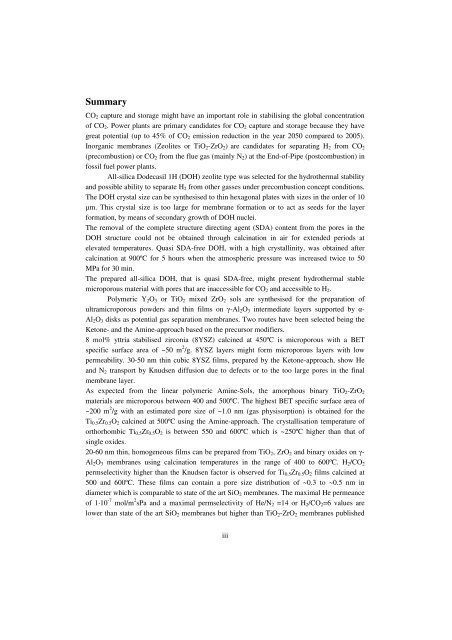Inorganic Microporous Membranes for Gas Separation in Fossil Fuel ...
Inorganic Microporous Membranes for Gas Separation in Fossil Fuel ...
Inorganic Microporous Membranes for Gas Separation in Fossil Fuel ...
You also want an ePaper? Increase the reach of your titles
YUMPU automatically turns print PDFs into web optimized ePapers that Google loves.
Summary<br />
CO2 capture and storage might have an important role <strong>in</strong> stabilis<strong>in</strong>g the global concentration<br />
of CO2. Power plants are primary candidates <strong>for</strong> CO2 capture and storage because they have<br />
great potential (up to 45% of CO2 emission reduction <strong>in</strong> the year 2050 compared to 2005).<br />
<strong>Inorganic</strong> membranes (Zeolites or TiO2-ZrO2) are candidates <strong>for</strong> separat<strong>in</strong>g H2 from CO2<br />
(precombustion) or CO2 from the flue gas (ma<strong>in</strong>ly N2) at the End-of-Pipe (postcombustion) <strong>in</strong><br />
fossil fuel power plants.<br />
All-silica Dodecasil 1H (DOH) zeolite type was selected <strong>for</strong> the hydrothermal stability<br />
and possible ability to separate H2 from other gasses under precombustion concept conditions.<br />
The DOH crystal size can be synthesised to th<strong>in</strong> hexagonal plates with sizes <strong>in</strong> the order of 10<br />
µm. This crystal size is too large <strong>for</strong> membrane <strong>for</strong>mation or to act as seeds <strong>for</strong> the layer<br />
<strong>for</strong>mation, by means of secondary growth of DOH nuclei.<br />
The removal of the complete structure direct<strong>in</strong>g agent (SDA) content from the pores <strong>in</strong> the<br />
DOH structure could not be obta<strong>in</strong>ed through calc<strong>in</strong>ation <strong>in</strong> air <strong>for</strong> extended periods at<br />
elevated temperatures. Quasi SDA-free DOH, with a high crystall<strong>in</strong>ity, was obta<strong>in</strong>ed after<br />
calc<strong>in</strong>ation at 900ºC <strong>for</strong> 5 hours when the atmospheric pressure was <strong>in</strong>creased twice to 50<br />
MPa <strong>for</strong> 30 m<strong>in</strong>.<br />
The prepared all-silica DOH, that is quasi SDA-free, might present hydrothermal stable<br />
microporous material with pores that are <strong>in</strong>accessible <strong>for</strong> CO2 and accessible to H2.<br />
Polymeric Y2O3 or TiO2 mixed ZrO2 sols are synthesised <strong>for</strong> the preparation of<br />
ultramicroporous powders and th<strong>in</strong> films on γ-Al2O3 <strong>in</strong>termediate layers supported by α-<br />
Al2O3 disks as potential gas separation membranes. Two routes have been selected be<strong>in</strong>g the<br />
Ketone- and the Am<strong>in</strong>e-approach based on the precursor modifiers.<br />
8 mol% yttria stabilised zirconia (8YSZ) calc<strong>in</strong>ed at 450ºC is microporous with a BET<br />
specific surface area of ~50 m 2 /g. 8YSZ layers might <strong>for</strong>m microporous layers with low<br />
permeability. 30-50 nm th<strong>in</strong> cubic 8YSZ films, prepared by the Ketone-approach, show He<br />
and N2 transport by Knudsen diffusion due to defects or to the too large pores <strong>in</strong> the f<strong>in</strong>al<br />
membrane layer.<br />
As expected from the l<strong>in</strong>ear polymeric Am<strong>in</strong>e-Sols, the amorphous b<strong>in</strong>ary TiO2-ZrO2<br />
materials are microporous between 400 and 500ºC. The highest BET specific surface area of<br />
~200 m 2 /g with an estimated pore size of ~1.0 nm (gas physisorption) is obta<strong>in</strong>ed <strong>for</strong> the<br />
Ti0.5Zr0.5O2 calc<strong>in</strong>ed at 500ºC us<strong>in</strong>g the Am<strong>in</strong>e-approach. The crystallisation temperature of<br />
orthorhombic Ti0.5Zr0.5O2 is between 550 and 600ºC which is ~250ºC higher than that of<br />
s<strong>in</strong>gle oxides.<br />
20-60 nm th<strong>in</strong>, homogeneous films can be prepared from TiO2, ZrO2 and b<strong>in</strong>ary oxides on γ-<br />
Al2O3 membranes us<strong>in</strong>g calc<strong>in</strong>ation temperatures <strong>in</strong> the range of 400 to 600ºC. H2/CO2<br />
permselectivity higher than the Knudsen factor is observed <strong>for</strong> Ti0.5Zr0.5O2 films calc<strong>in</strong>ed at<br />
500 and 600ºC. These films can conta<strong>in</strong> a pore size distribution of ~0.3 to ~0.5 nm <strong>in</strong><br />
diameter which is comparable to state of the art SiO2 membranes. The maximal He permeance<br />
of 1·10 -7 mol/m 2 sPa and a maximal permselectivity of He/N2 =14 or H2/CO2=6 values are<br />
lower than state of the art SiO2 membranes but higher than TiO2-ZrO2 membranes published<br />
iii

















